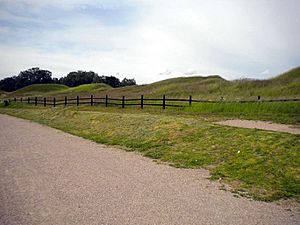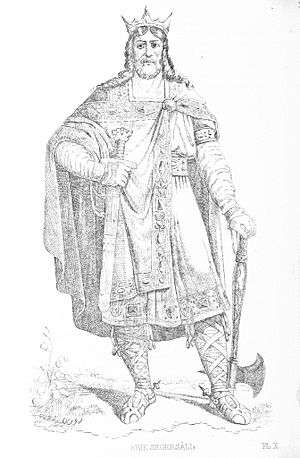Eric the Victorious facts for kids
Quick facts for kids Eric the Victorious |
|
|---|---|

Eric praying to Odin before the Battle of Fýrisvellir, as envisioned by Twentieth century artist Jenny Nyström
|
|
| King of Sweden | |
| Reign | c. 970 – c. 995 |
| Successor | Olof Skötkonung |
| Born | c. 945 |
| Died | c. 995 |
| Burial | Old Uppsala |
| Consort |
|
| Issue | Olof Skötkonung |
| House | Munsö |
| Father |
|
| Religion | Pagan, possibly briefly Christian |
Eric the Victorious (in Old Norse: Eiríkr inn sigrsæli, in Modern Swedish: Erik Segersäll; born around 945 – died around 995) was an early Swedish king. He ruled from about 970 to 995.
Even though there might have been earlier Swedish kings, Eric is the first one whose rule is confirmed by different independent sources. Because of this, most lists of Swedish rulers start with him. His son, Olof Skötkonung, is known as the first king accepted by both the original Swedes near Lake Mälaren and the Geats near Lake Vättern.
Some old stories mention a king named Emund Eriksson before Eric, but we don't know if he was Eric's father. Other tales talk about a Björn Eriksson, but these stories are not always seen as reliable by historians.
Contents
Eric's Kingdom and Victories
Eric's first kingdom was in Uppland and nearby areas of Sweden. He earned the name Segersäll, which means Victorious or blessed with victory. He got this name after winning a big battle called the Battle of Fýrisvellir. This battle happened near Uppsala against an invading army from the south.
The exact size of Eric's kingdom is not fully known. It likely included the main Swedish lands around Lake Mälaren. It might have also stretched south along the Baltic Sea to Blekinge. Some old writings even say he became King of Denmark after defeating King Sweyn Forkbeard.
Eric probably started a system called ledung in the areas around Mälaren. This was a way to call up all free farmers to serve in the army or navy. He also likely founded the town of Sigtuna. This town still exists today and was where the first Swedish coins were made for his son, King Olof Skötkonung.
Stories from the Sagas
Eric the Victorious appears in many sagas. These are old Nordic tales that were passed down by word of mouth. In these stories, he is often described as the son of a king named Björn (III) Eriksson. He is also said to have ruled alongside his brother, Olaf.
One saga tells of his marriage to the famous Queen Sigrid the Haughty. After their divorce, Eric supposedly gave her all of Götaland as her own land. According to another saga, Eymund's saga, he then married a new queen, Aud. She was the daughter of Haakon Sigurdsson, who ruled Norway.
The sagas also say that Eric's brother Olaf died. A new co-ruler was needed, but the Swedes supposedly did not want Eric's wild nephew, Styrbjörn. So, Eric gave Styrbjörn 60 longships. Styrbjörn then left to live as a Viking. He became the ruler of Jomsborg and an ally of the Danish King Harold Bluetooth. Styrbjörn even married Harold's daughter, Tyra.
Styrbjörn later returned to Sweden with an army. However, King Harold and the Danish troops seem to have turned back. Eric won the Battle of Fýrisvellir. According to the saga Styrbjarnar þáttr Svíakappa, Eric won after making a promise to Odin. He promised that if he won, he would give himself to Odin in ten years.
Two poems by Thorvaldr Hjaltason describe this battle. They mention how Eric completely defeated an enemy army at Fýrisvellir. The poems also say that the Vikings had more fighters but were still easily captured when they attacked Sweden. Only those who ran away survived.
Some runestones in Scania, which was part of Denmark back then, also mention a battle at Gamla Uppsala. These stones talk about attackers being defeated and fleeing. These stones have often been linked to the Battle of Fýrisvellir. However, their dates might be from the next century, so it's not certain.
Adam of Bremen's Account
A German church writer named Adam of Bremen wrote about King Eric around 1075. His story is much older than the sagas and is quite different. Adam said his information came from King Sweyn II of Denmark, whom he interviewed.
Adam writes that Eric ruled after a king named Emund Eriksson. He does not mention the Battle of Fýrisvellir. Instead, he says Eric gathered a large army and invaded Denmark to fight King Sweyn Forkbeard. The reason for this attack is not clear. However, it seems to have involved an alliance between Eric and a powerful king of the Polans, Bolesław. This Polish king gave Eric his sister or daughter in marriage. This princess might have been Gunhild of Wenden or Świętosława.
Eric's invasion of Denmark was successful. Many sea battles were fought, and the Danish forces were destroyed. After his victory, Eric ruled Denmark for a while. Sweyn Forkbeard had to flee, first to Norway, then to England, and finally to Scotland.
Adam also says that Eric's rule in Denmark led to more Viking raids in northern Germany. A fleet of Swedish and Danish ships sailed up the Elbe River and landed in Saxony. A Saxon army fought the Vikings but was badly beaten. Many important Saxons were captured. The Vikings then hurt their remaining prisoners and left them on the shore. However, the Saxons fought back and defeated the Vikings.
Adam describes Eric as a pagan king who was at first very against Christianity. But during his rule, many missionaries came to preach. Eric eventually agreed to be baptized, probably while he was in Denmark. If this is true, he was the first Swedish king to become Christian. After some time, Eric is said to have gone back to the old religion of his ancestors.
When Eric died, Sweyn Forkbeard returned from exile and took back Denmark. He is also said to have married Eric's widow. This created a link between the Swedish and Danish royal families.
Adam's story suggests Eric died between 992 and 995. According to Snorre Sturlasson, Eric died in Uppsala. Historians have different ideas about Eric's marriages because Adam's story is different from other sources. The details about his conquest of Denmark have also been questioned. However, a recent look at the evidence suggests it's possible he had some control over Danish lords. Overall, both Adam's records and the Nordic sagas show Eric as a strong and successful ruler.
Eric's Family

Different stories and sagas mention several women as Eric's wives. These include Sigrid, Świętosława, Gunhild, and Aud. It's possible that two or three of these names refer to the same person.
Eric is said to have had four children:
- Olof Skötkonung (died 1022): He is Eric's only child confirmed by history.
- Emund: He supposedly ruled part of the kingdom under his brother Olof.
- Holmfrid: Sometimes thought to be Eric's daughter, not Olof's sister. She was married to Sweyn Haakonsson.
- A daughter: She married a man named Åke and was the grandmother of Ingvar the Far-Travelled.
Eric's nephew Styrbjörn and niece Gyrid were supposedly the children of his brother and co-ruler, Olaf.
See also
 In Spanish: Erico el Victorioso para niños
In Spanish: Erico el Victorioso para niños
- List of Swedish monarchs
- Adam of Bremen
- Icelandic sagas



